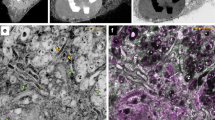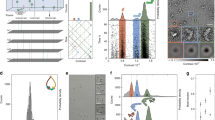Abstract
ATTEMPTS to use conventional transmission electron microscopy to visualise single heavy atoms attached to protein thiol residues are usually unsuccessful, because the signal due to the heavy atom is generally too weak to be detected against background noise and the signal due to the protein and negative stain (if used). This is unfortunate because such a technique would prove invaluable as a means of determining molecular orientations in multiprotein assemblies and relative positions of thiol residues within individual molecules. As one approach to this problem we have devised and report here a method by which the signal at the thiol residues can be increased by introducing several heavy atoms at each site. This considerably aids ultrastructural localisation by electron microscopy, particularly in the presence of heavy metal negative stains such as uranyl acetate. We illustrate the technique by visualising the thiol residues in uranyl acetate-negatively stained magnesium paracrystals of rabbit skeletal muscle tropomyosin. Although the conditions we report gave satisfactory results with tropomyosin, they should only be considered as a guide when labelling other proteins, as the optimum reaction conditions may be different in some cases.
This is a preview of subscription content, access via your institution
Access options
Subscribe to this journal
Receive 51 print issues and online access
$199.00 per year
only $3.90 per issue
Buy this article
- Purchase on Springer Link
- Instant access to full article PDF
Prices may be subject to local taxes which are calculated during checkout
Similar content being viewed by others
References
O'Connor, G. N., Crawford, J. V. & Wang, C-H. J. org. Chem. 30, 4090–4091 (1965).
Diakiw, V., Raston, C. H., Stewart, M. & White, A. H. Aust. J. Chem. 31, 1021–1029 (1978).
Cohen, C., Caspar, D. L. D., Parry, D. A. D. & Lucas, R. M. Cold Spring Harb. Symp. quant. Biol. 36, 205–216 (1971).
Stone, D., Sodek, J., Johnson, P. & Smillie, L. B. Proc. IX FEBS Meet. Budapest 31, 125–137 (1975).
Stewart, M. Proc. R. Soc. Lond. B 190, 257–266 (1975).
Guidotti, G. & Konigsberg, W. J. biol. Chem. 239, 1474–1484 (1964).
Caspar, D. L. D., Cohen, C. & Longley, W. J. molec. Biol. 41, 87–107 (1969).
Ohtsuki, I. J. Biochem., Tokyo 75, 753–765 (1974).
Stewart, M. & McLachlan, A. D. J. molec. Biol. 103, 251–269 (1976).
Stewart, M. FEBS Lett. 53, 5–7 (1975).
Lehrer, S. S. Proc. natn. Acad. Sci. U.S.A. 72, 3377–3381 (1975).
Lowry, O. H., Rosenberg, N. J., Farr, A. L. & Randall, R. J. J. biol. Chem. 93, 265–275 (1951).
Author information
Authors and Affiliations
Rights and permissions
About this article
Cite this article
STEWART, M., DIAKIW, V. Electron microscopic location of protein thiol residues. Nature 274, 184–186 (1978). https://doi.org/10.1038/274184a0
Received:
Accepted:
Issue Date:
DOI: https://doi.org/10.1038/274184a0
This article is cited by
-
Immunogold labeling in scanning electron microscopy
Histochemistry and Cell Biology (1996)
Comments
By submitting a comment you agree to abide by our Terms and Community Guidelines. If you find something abusive or that does not comply with our terms or guidelines please flag it as inappropriate.



